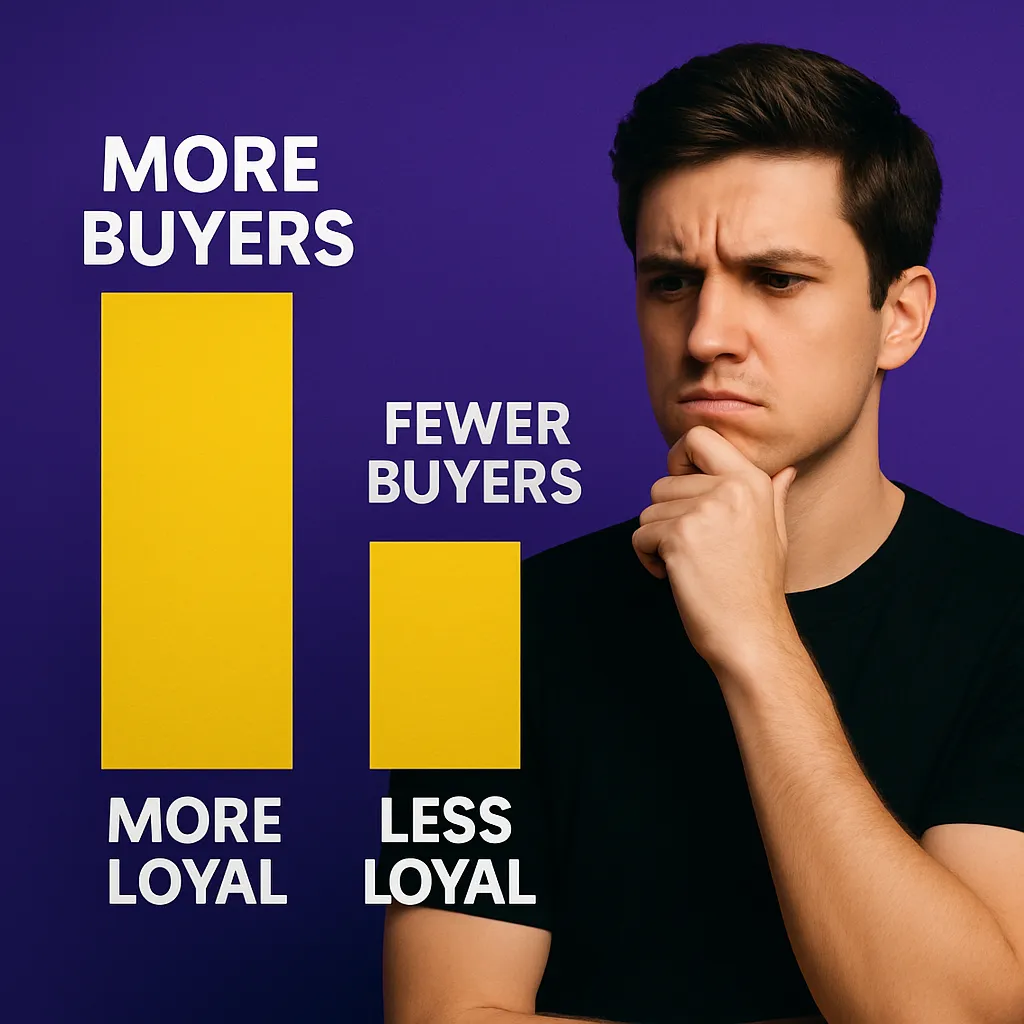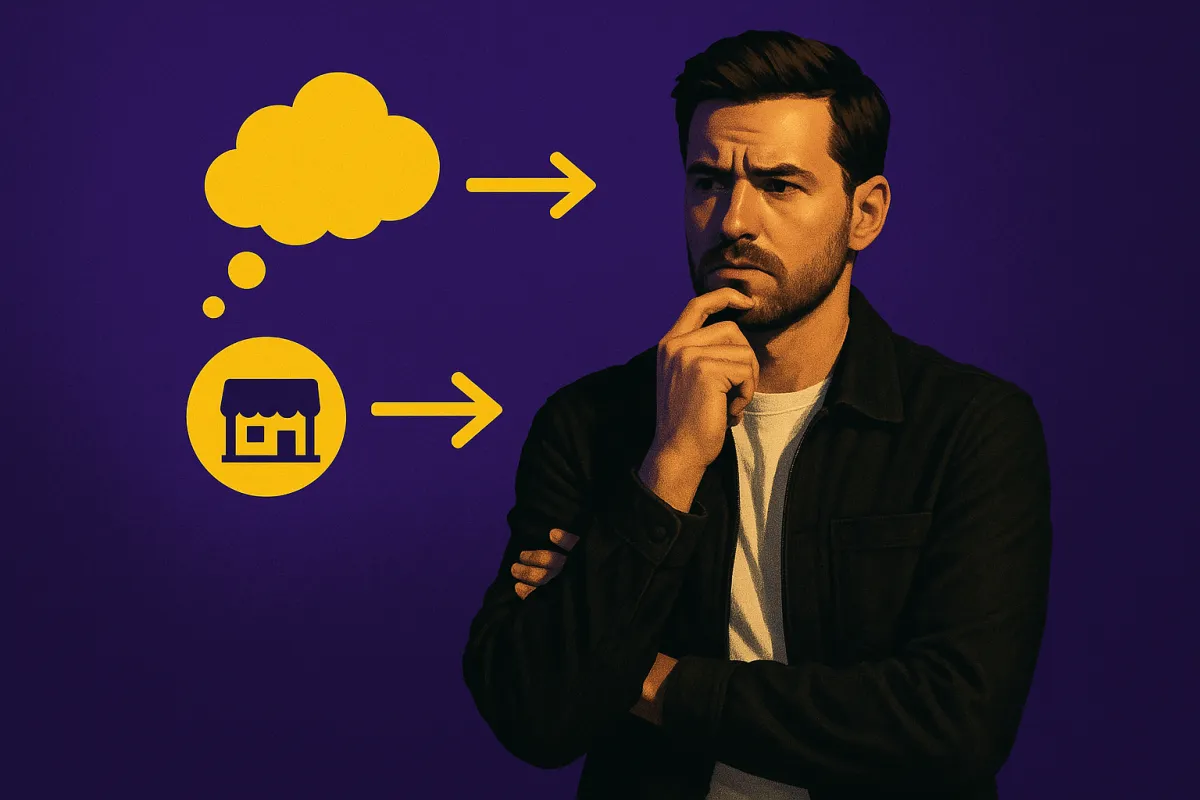By German Tirado, August 1, 2025
Table of Contents
Introduction: Why Small Brands Can't Rely on Devoted Customers to Survive
What Is the Double Jeopardy Law?
Loyalty Is Not a Strategy
Why Niche Brands Aren’t Safer
Mental and Physical Availability: The Real Growth Levers
The Data: Double Jeopardy in Action
What Smart Small Brands Do Instead
Conclusion: Why Small Brands Must Escape the Loyalty Trap
Frequently Asked Questions (FAQs)
Works Cited
Introduction: Why Small Brands Can't Rely on Devoted Customers to Survive

In today’s digital marketing era, it’s become trendy to celebrate the idea of niche brands with passionate fans. You’ll hear it from entrepreneurs, marketing gurus, and brand consultants alike: “We’re not for everyone, we’re for the few who love us deeply.” It’s a seductive message. It promises survival through brand loyalty, emotional connection, and differentiation, without needing to chase mass-market appeal.
But this belief is not only misleading, it’s dangerous.
Decades of research in marketing science, especially from the Ehrenberg-Bass Institute, show that small brands don’t thrive on loyalty. In fact, they suffer from a well-documented law called the Double Jeopardy Effect—a phenomenon observed across thousands of brands, categories, and markets. According to this law, smaller brands face a twofold disadvantage:
They have fewer customers (lower market penetration)
And those customers are less loyal (lower purchase frequency and retention) [1].
This flies in the face of popular advice that suggests small businesses can “win by building a loyal customer base.” The truth is that brand growth does not come from focusing on loyalty programs, customer engagement tactics, or niche messaging. Growth comes from reaching more category buyers, building mental availability across Category Entry Points (CEPs), and increasing physical availability across channels and formats [2][5].
In other words, the hard data says that penetration not devotion, drives growth.
If your brand is small, focusing exclusively on a devoted few is not a strength, it’s a strategic liability. In this article, we’ll unpack the Double Jeopardy Law, debunk the loyalty myth, and show you what effective brand growth strategies actually look like for small businesses, B2B marketers, and local service brands alike.
Whether you’re an internet marketing service, a specialty food brand, a SaaS tool, or a boutique retailer, the message is the same: stop building deeper bonds with the few and start building memory structures with the many.
1. What Is the Double Jeopardy Law?

The Double Jeopardy Law is a universal pattern in buyer behavior: brands with smaller market share suffer both from having fewer buyers and those buyers being less loyal.
Originally observed in the 1960s and later confirmed in hundreds of categories across B2C and B2B markets, this pattern holds true whether you’re selling soap, insurance, or airplane engines [1][4].
“It is not possible to sustainably grow by focusing on loyalty alone. A firm with more market share will have many more buyers who are slightly more loyal.” [4]
This empirical law contradicts the notion that a small but loyal audience is a viable long-term strategy. The reality is: small brands get punished twice, they lose on size and on loyalty.
2. Loyalty Is Not a Strategy

Marketing folklore loves to talk about loyalty. Phrases like “it costs less to retain a customer than to acquire a new one” are thrown around as if they’re gospel. But in practice, most customers, even “loyal” ones buy from multiple brands.
This is explained by another marketing law called the Duplication of Purchase Law, which shows that customers of Brand A also buy from Brands B and C, often in proportion to their market share [2].
That means loyalty is not an independent lever that small brands can pull. Instead, it’s an outcome of penetration. Larger brands earn slightly more loyalty precisely because they're more mentally and physically available to more people [1].
3. Why Niche Brands Aren’t Safer

“Niche” is often used to justify small market size. But unless the niche is truly isolated (e.g., religious texts in Ancient Aramaic), buyers of niche brands still operate within the broader category, and behave like any other buyer.
Even cult-like brands face churn. Their customers are still exposed to other options. And due to memory decay and the law of buyer behavior, they’re still more likely to switch to larger brands that are easier to think of and find [3].
“We don’t observe sustainable growth coming from a range of different paths. The real world shows one clear path to growth: getting more customers to buy from you in any time period.” [4]
4. Mental and Physical Availability: The Real Growth Levers

Growth doesn’t come from deepening loyalty. It comes from:
Reaching more buyers
Being thought of more often
Being easier to find and buy
These are called:
Mental Availability – Being easily thought of in many buying situations (via Category Entry Points).
Physical Availability – Being easy to buy across locations, channels, formats, and timing.
Most small brands lack both. That’s what keeps them small—and makes them fragile [1][4].
To grow, a brand must build wider and fresher memory networks—mental connections between the brand and real-world buying situations (CEPs). These include things like:
When I run out of stock.
When I’m trying to impress a new client.
When I need a fast solution at 9pm.
These are the moments when buyers decide. Big brands have more CEP associations. Small brands need to build theirs, fast [5].
5. The Data: Double Jeopardy in Action

The Ehrenberg-Bass Institute has demonstrated the Double Jeopardy Law across B2C and B2B categories:
In UK business banking, brands with fewer customers had lower scores for product usage, favorite brand rating, and sole usage [4].
In US business insurance, smaller brands like Progressive Commercial had higher defection rates than dominant players like Allstate [4].
In telecom, aviation, concrete supply, and dozens more, smaller brands consistently showed lower loyalty metrics per buyer [4].
And it’s not just behavioral loyalty. Mental availability is lower too. A study on US business insurance found that the fewer Category Entry Points (CEPs) a brand is linked to in memory, the higher the probability of defection [5].
Each additional CEP association lowered the defection rate by 5% on average [5].
6. What Smart Small Brands Do Instead

Rather than chasing mythical brand love or investing only in “customer experience,” smart small brands follow the data.
Here’s how to fight Double Jeopardy:
Prioritize Customer Acquisition
Run broad-reach advertising.
Stop over-segmenting or hyper-targeting your “core fans.”
Build Mental Availability via CEPs
Identify the When, Where, While, With/Instead-of, For Whom, How Feeling, and Why contexts your buyers face [5].
Develop distinct, clear creative executions around each CEP.
Improve Physical Availability
Expand distribution channels.
Increase product variants, accessibility, formats, and touchpoints.
Use Distinctive Brand Assets
Ensure your logo, colors, audio, and taglines are instantly recognizable [3].
Track Penetration, Not Loyalty
Monitor category buyers reached, brand-linked CEPs, and share of voice.
In other words: look like a big brand, act like a big brand, and grow like a big brand.
Conclusion: Why Small Brands Must Escape the Loyalty Trap and Embrace Evidence-Based Growth
The idea that niche brands can succeed through loyalty alone is a comforting illusion, but one that contradicts decades of replicated marketing science. The Double Jeopardy Law shows us that small brands not only have fewer customers, they also suffer from lower loyalty among those customers. That’s a double disadvantage no amount of “brand love” or “community engagement” can offset [1][4].
Loyalty isn’t a growth strategy. It’s a side effect of scale.
To grow your brand, whether you're running a local business, a B2B service, a DTC e-commerce brand, or a startup SaaS platform, you need to focus on increasing market penetration. That means:
Expanding reach through broad-reach advertising.
Building mental availability by linking your brand to more Category Entry Points (CEPs), the real-world buying situations where your brand needs to come to mind.
Improving physical availability so your product or service is easy to find, easy to buy, and available in more formats, channels, and moments [2][5].
Leveraging distinctive brand assets that help buyers recognize and remember you instantly—even in cluttered environments [3].
These are not opinions or passing fads, they are empirically proven growth drivers. Small brands that fail to embrace these principles will remain trapped in their size, vulnerable to churn, and increasingly forgotten by category buyers who don’t think of them when it counts.
Yes, it’s tempting to believe that a devoted customer base, brand storytelling, or unique product features will be enough. But the data is unequivocal: the brands that grow are the brands that are easier to buy, mentally and physically.
If you're running a small business or niche brand, your job isn’t to deepen relationships with the few—it’s to reach the many, build memory structures, and remove friction from the buying process.
Because real brand growth doesn’t come from deeper loyalty, it comes from broader reach.
Frequently Asked Questions (FAQs)
Q1: What is the Double Jeopardy Law in marketing?
A: The Double Jeopardy Law states that smaller brands not only have fewer customers (lower market penetration) but also suffer from lower customer loyalty. This law has been confirmed across hundreds of product categories and applies in both B2C and B2B markets [1].
Q2: Can a niche brand survive with a small but loyal customer base?
A: Not sustainably. While some niche brands may appear to have passionate fans, the data shows that growth comes from acquiring more customers, not from having highly loyal few. Even niche buyers tend to buy from larger brands as well [2].
Q3: Why is loyalty lower in small brands?
A: Loyalty is a by-product of brand size. Large brands are more mentally and physically available—so customers buy them more often. Small brands are less likely to be remembered or stocked, leading to lower purchase frequency and higher churn [1][4].
Q4: What’s the difference between mental availability and physical availability?
A:
Mental availability refers to how easily a brand comes to mind across different Category Entry Points (CEPs), like “when I need a quick fix” or “when my usual brand is out of stock.”
Physical availability refers to how easy a brand is to buy—being in more locations, channels, formats, and times [2][5].
Q5: How can small brands grow if they can’t rely on loyalty?
A: Small brands grow by:
Reaching more category buyers through broad-reach advertising.
Building mental availability via distinctive, CEP-linked marketing.
Expanding physical availability across sales channels and formats.
Using distinctive brand assets to make the brand easy to spot and recall [3][5].
Q6: Should small businesses invest in loyalty programs?
A: Not as a core growth strategy. Loyalty programs may offer short-term incentives, but they don’t counteract the underlying problem of low penetration. For small brands, the priority should be customer acquisition and salience building, not retention schemes [1].
Q7: Is the Double Jeopardy Law relevant for B2B brands?
A: Absolutely. The law has been validated in B2B categories such as insurance, telecommunications, finance, and software. B2B buyers show the same mental patterns and switching behaviors as consumers do—because they’re still human [4][5].
Works cited
[1] Sharp, B. (2010). How Brands Grow: What Marketers Don’t Know. Oxford University Press.
[2] Sharp, B., Romaniuk, J., & Kennedy, R. (2016). How Brands Grow: Part 2 – Emerging Markets, Services, Durables, New and Luxury Brands. Oxford University Press.
[3] Romaniuk, J. (2023). Building Distinctive Brand Assets: A Practical Guide to Brand Growth. Oxford University Press.
[4] Ehrenberg-Bass Institute. (2021). The Double Jeopardy Law in B2B Shows the Way to Grow. Retrieved from the Ehrenberg-Bass Institute Reports.
[5] Romaniuk, J. (2022). Category Entry Points in a Business-to-Business (B2B) World. Ehrenberg-Bass Institute.
Address
Phone: 725-240-6870
Email : [email protected]
Address : 6440 Sky Pointe Dr. #140-341 Las Vegas, NV 89131
Artificial Intelligence
Marketing & Branding
Marketing & Branding
©2025 Max Digital Edge | All Rights Reserved
